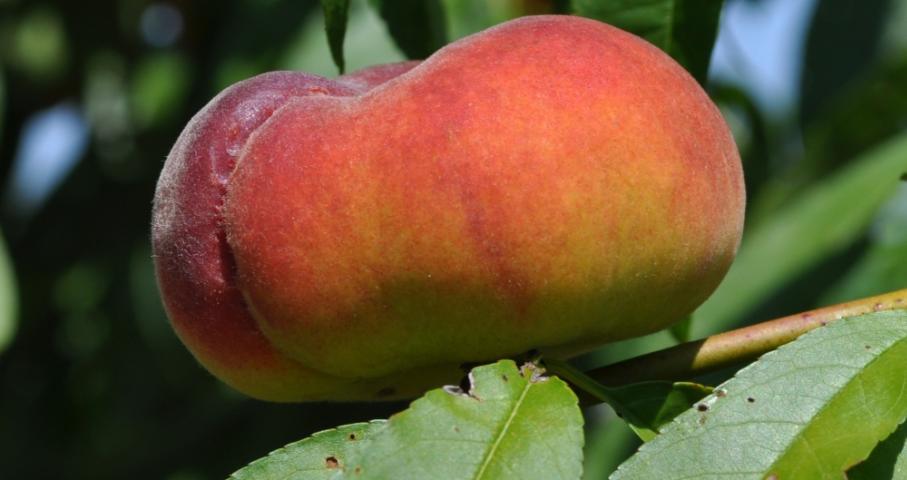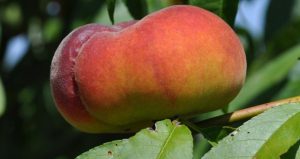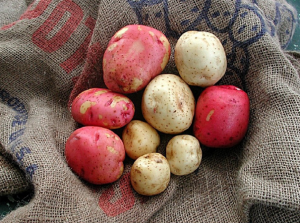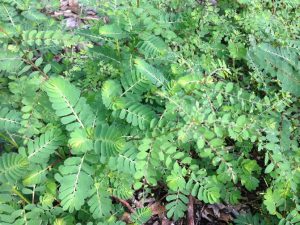
by Ray Bodrey | Mar 6, 2019
I’m a native of Georgia, growing up just south of the region known as “peach country”. To me, there’s nothing better than a ripe, juicy peach on a summer day. I thought I had seen it at all when it came to peaches. That changed on a trip to the southwest U.S.
A few years ago, I was fortunate to make the voyage to Utah for the National Association of County Agricultural Agents annual meeting. A small group of county agents also participated in a pre-tour of the southwest region of Utah. This is where I found a treasure in the desert, as a host extension agent shared some of his oddly shaped, Saturn peaches from a nearby orchard.
The Saturn peach is a favorite in Utah and a favorite for hundreds of years in Asia. This is an asymmetrically shaped peach, with white, firm flesh. Some refer to this as a “donut peach”. It is an interesting fruit, that I must admit was one of the most delicious peaches that I’ve ever eaten.

Figure 1. “UFO” Peach.
Credit: Ali Sarkhosh, Mercy Olmstead, Jose Chaparro, Pete Andersen and Jeff Williamson. UF/IFAS Extension
I began to ponder why this peach variety was one that I had never encountered? After consulting with extension agents in neighboring southeastern states, I found that many universities had experimented with the variety. However, pitfalls in climate acclimation, mechanical harvesting (because the fruit is not round, harvesting equipment can damage) and marketing were discouraging. From a large commercial production interest, even if a viable yield could be grown in the region and custom designed harvesters were feasible, hurdles would still remain regarding the difficulty of marketing an introduced variety that has an unfamiliar and imperfect shape, versus well established varieties that can be graded as select. However, a healthy market may exist for small farms as novelty crop.
Furthermore, in 2002 UF/IFAS researchers breed and patented a similar variety of the Saturn peach that thrives anywhere in Florida. The Australia saucer peach was used to breed this new variety, known as the flying saucer or “UFO”. This peach has non-melting flesh with that unique donut shape, not unlike the Saturn. These trees are large and vigorous growing, with a semi-upright growth habit. The UFO produces moderately heavy crop loads of large, firm fruit with yellow flesh and semi-freestone pits that has a fruit development period of 95 days. As seen in figure 1, the skin develops 50–70% blush. This cultivar is particularly susceptible to ethylene that is released during dormant pruning, which can result in significant flower bud abortion. Thus, pruning is only recommended during the summer period.
Where do I find such a tree? Growers can purchase from nurseries who are licensed by the University to grow patented varieties. What about homeowners? Check your local garden centers. Now is great time to plant.
For more information please contact your local extension office.
Supporting information for this article obtained through past interviews of Dr. Wayne Sherman, Professor Emeritus, Department of Horticultural Sciences, UF/IFAS as well as from the following the UF/IFAS EDIS publication: “Florida Peach and Nectarine Varieties” by Ali Sarkhosh, Mercy Olmstead, Jose Chaparro, Pete Andersen and Jeff Williamson: https://edis.ifas.ufl.edu/pdffiles/MG/MG37400.pdf
UF/IFAS Extension is an Equal Opportunity Institution.

by Ray Bodrey | Feb 5, 2019
The “new” or “Irish” potato is one of America’s most popular vegetables and a fine cool season crop choice for gardeners in the Panhandle.
The history of the potato is quite interesting. The potato was first domesticated in Peru between 3000 BC-2000 BC. Potatoes were first planted, where in states? Idaho, of course, as early as the 1830’s. By 1900, Idaho’s production exceeded one million bushels. Potatoes are diverse in appearance and uses. Potatoes are high in nutrition and have fewer calories than other starches such as rice, pasta and bread.
In Florida, potatoes can be planted in the winter or early spring. February 1st to March 10th is the prime planting range. As a general production rule, 100 lbs. of seed potatoes will typically yield around ten bushels. Be sure to use only certified seed potatoes for best planting stock. These can be found at most garden centers. For best results, select varieties recommended for North Florida like ‘Atlantic’, ‘Sebago’, and ‘Superior’ (all round, white potatoes). Also, ‘Red Lasorda’ and ‘Red Pontiac’ are viable round, red potatoes. Resist using potato stock bought from produce sections at grocery stores. Odds are, symptoms of a number of diseases will occur. For planting, each seed potato should be cut into smaller pieces, displaying two or more eyes. To prevent fungal pathogens, the most common culprit in potato production, use a light dusting of a fungicide to combating decay.

Figure 1. Red and white potatoes grown in Florida.
Credit: C. Hutchinson. UF/IFAS Extension
It’s best to plant seed potatoes in raised rows, where the height of the mound is 6 inches and the width is 1 to 2 feet. Row spacing should be at least 3 feet apart. The seed furrow should be 3-4 inches in depth, through the center of the row. Seed potatoes should be planted in 1 foot intervals. Cover, and water freshly planted rows. Fertilizing is key. One quart of 10-10-10 fertilizer for every 50 feet of row space is needed for the initial application. Through the season, for every 3 weeks, side dress the rows with a pound of 10-10-10 per 50 feet of row space.
Following these steps will ensure a productive potato crop. For more information please contact your local county extension office.
Supporting information for this article and further information can be found in the following the UF/IFAS EDIS publication: “Growing Potatoes in the Florida Home Garden” by Christian T. Christensen, Joel Reyes-Cabrera, Libby R. Rens, Jeffrey E. Pack, Lincoln Zotarelli, Chad Hutchinson, Wendy J. Dahl, Doug Gergela, and James M. White: https://edis.ifas.ufl.edu/pdffiles/HS/HS18300.pdf
UF/IFAS Extension is an Equal Opportunity Institution.

by Ray Bodrey | Sep 6, 2018

Figure 1: Chamberbitter, a common annual weed.
Credit: Mary Salinas, UF/IFAS Extension Santa Rosa County.
With daily rainfall occurring regularly, coupled with humid temperatures, summer annual weeds have had a mighty boost in growth. Chamberbitter, Florida pusley, sedge and oxalis are just some examples of the many weeds that are exploding across our landscape.
Chamberbitter (Phyllanthus urinaria) is found as north as Illinois and as west as Texas, but thrives in lower southeastern states. It’s a headache for homeowners as well as pasture managers. The foliage resembles that of the mimosa tree (Albizia julibrissin) and can be confused with the native mimosa groundcover, known as powderpuff mimosa (Mimosa strigillosa). This plant grows upright and develops a long taproot. Wart-like seeds can be found on the underside of the branch.
Florida Pusley (Richardia scabra L.) also known as Florida snow or Mexican clover, has recently blanketed landscapes in the Panhandle with white flowers. It’s a persistent weed that moves quickly.
Sedges and sedge-like plants (Cyperus ssp.), known as kyllinga, are species that emerge in late spring and thrive in summer months in warm, moist climates. Excessive irrigation or areas with poor drainage create a very hospitable environment for these weeds. Sedges are annual grass-like plants have an elaborate flower-bearing stems. Yellow and purple nutsedge are the most common species. Kyllingas have smaller leaves and are less vertical. Sedges and kyllingas are fast spreading, and reproduce through seed and rhizomes, or underground tubers.
Oxalis or yellow woodsorrel (Oxalis stricta) have heart-shaped lobes and have a bright yellow flower. Oxalis reproduces by seed and have a narrow “okra-like” seed pod.

Figure 1: (L to R) Chamberbitter, Pusley, Sedge, Kyllinga & Oxalis.
Credit: Stephen H. Brown, UF/IFAS Extension Lee County
What about control? Some cultural control methods are hand removal and mowing frequently to offset the life cycle, but these practices alone will most likely not solve the problem. There are many broad spectrum herbicides that can be used to control these weeds with good results, but you must be persistent. Some are season long applied products. However, most effective products need to be applied in cooler temps than we have now. Consecutive days of temperatures of less than 90 degrees would be optimal. Applying the chemical otherwise will most likely harm the turfgrass. Be aware, some productions will injure or kill centipede and St. Augustine, but are safe to use on other turfgrasses like bermuda, bahia and zoysia. Be sure to read the label and follow the directions and precautions.
Another option is non-selective herbicides, like glyphosate, which can be used in thick patches or for spot treatment. When using a selective herbicide, remember to protect turfgrass and other plants from spray drift or any contact, especially regarding ornamental plants and trees.
Contact your local county extension office for more information.
Supporting information for this article is from the following online publications:
Clemson Cooperative Extension publication: “Chamberbitter”, Bulletin HCIC 2314: http://www.clemson.edu/extension/hgic/pests/pdf/hgic2314.pdf
UT Institute of Agriculture document, “Nutsedge and Kyllinga Species” by Mathew T. Elmore, James T. Brosnan and Gregory K. Breeden: http://www.tennesseeturfgrassweeds.org/Lists/Fact%20Sheets/Attachments/23/W260updated2015.pdf
UF/IFAS EDIS publications: “Yellow Woodsorrel (Oxalis) Biology and Management in Turf” by J. Bryan Unruh, Ramon G. Leon, and Darcy E. P. Telenko: http://edis.ifas.ufl.edu/pdffiles/EP/EP38500.pdf
“Weed Management Guide for Florida Lawns” by J. Bryan Unruh, Ramon G. Leon, Barry J. Brecke, and Laurie E. Trenholm: http://edis.ifas.ufl.edu/pdffiles/EP/EP14100.pdf
UF/IFAS Extension is an Equal Opportunity Institution.
by Ray Bodrey | Jul 11, 2018
Rabbiteye Blueberry cultivars are the primary species grown in the Panhandle and are much more popular than the Southern Highbush Blueberry that dominates production further south. Our environment is more hospitable to Rabbiteye; consequently, they tend to be more drought tolerant and less susceptible to disease. The harvest season for Rabbiteye Blueberries is also relatively long. Harvesting can extend from May to July, depending on cultivar selection.
Rabbiteye blueberry season starts to wrap up this month in the Panhandle, as late season cultivars begin their mature fruiting stage. This is also the time of year when we receive seemingly daily afternoon thunderstorms. These frequent rainfall events can compromise blueberry plants over the long term if good management measures are not in place.

Blueberry. Photo credit: Eric Zamora, UF IFAS.
One of the primary issues experienced with Rabbiteye Blueberry is Phytophthora Root Rot (PRR). This disease is a problem this time of year due to increased rain events and poor draining soils. PRR is caused by the fungus, Phytophthora cinnamomic. Infection by this fungus can lead to plant death if not managed; however, it is a condition that is easier to detect than most diseases. A clear sign of infection is the appearance of symptoms resembling fall color development in the foliage (leaves turning various shades of yellow, orange and red). Foliage color change is followed by leaf drop. A preventative fungicide can be used to treat this condition, but cultural methods (such as transplanting in well drained soils and using at least 3” of pine bark as mulch) will greatly reduce the risk of infection. Remember, blueberries, like azaleas and camellias are also acidic soil loving plants. Soils in the pH range of 4.0-5.5 are necessary for overall plant health and high fruit yields. Pine bark mulch, in addition to improving drainage and organic matter content, will assist in maintaining an acidic pH.
Botrytis Flower Blight or Gray Mold, caused by Botryospheria spp., is another potential issue experienced in late spring/early summer due to lingering moisture. To prevent Botrytis, avoid any overhead watering during the budding and flowering stage or keep watering to the early morning hours so moisture doesn’t linger overnight. Stem Blight can also occur this time of year. Symptoms of Stem Blight are of dying branches, which should simply be removed with sharp shears. There is no chemical control for stem blight and the best defense against this condition is good cultural practices that will in turn reduce plant stress.
In addition to potential fungal diseases, increased summer temperatures and rainfall often also bring an increase in insect populations. Most insecticides that are safe for ornamental landscape plants and fruit crops are safe for blueberries, just be sure to check the label for application rates, directions and precautions. Also, pay close attention to the label for the HI or harvest interval. This is the number of hours or days that need to pass before you can safely harvest fruit once an application of insecticide is made.
For more information on growing blueberries, please contact your local county extension office.
Supporting information for this article can be found in the UF/IFAS EDIS publication, “2017 Florida Blueberry Integrated Pest Management”, by Jeffrey G. Williamson, Phillip F. Harmon, Oscar E. Liburd & Peter Dittmar: http://edis.ifas.ufl.edu/pdffiles/HS/HS38000.pdf
& “Blueberry Gardener’s Guide”, by J. G. Williamson, P. M. Lyrene, and J. W. Olmstead: http://edis.ifas.ufl.edu/pdffiles/MG/MG35900.pdf
UF/IFAS Extension is an Equal Opportunity Institution.
by Ray Bodrey | Jun 7, 2018
Camellias are a Panhandle favorite, as the flowers can highlight a landscape with bright, vibrant colors in fall and winter. However, spring time can bring about these colors in a negative way, in the form of leaf gall.
The camellia is native to Asia and brought to America in the late 1700’s. These plants have proven to be a dependable addition to the southern landscape with minimal care. When camellias are correctly planted and cared for, minimal disease problems arise. However, camellias can contract leaf spot, dieback, root rot and bud and leaf gall.

Camellia Gall Credit: Patty Dunlap, Gulf County Master Gardener.
Leaf and bud galls are caused by the fungus Exobasidium vaccinia. The gall appears as thickened, waxy and enlarged leaves or buds during the cool spring months. One or several leaves on a single shoot may be affected. Once you’ve found infected leaves, no chemical control will be effective. Actually, no fungicide has been found very effective in combatting this condition. However, control can be accomplished in the home garden by simply pinching off and destroying infected leaves. Disease activity usually stops with warmer weather. A best management practice to curb infection is to reduce overhead watering during cool, wet weather periods of spring. Great news, this condition does not cause any long-term issues with the plant.
For more information regarding fungal issues in landscape plants, contact your local county extension office.
Fun camellia fact: The young leaves of the species, Camellia sinensis, are processed for tea, one of the world’s most popular drinks. Please see UF/IFAS EDIS publication, “Tea Growing in the Florida Landscape” by Jonathan H. Crane and Carlos F. Balerdi: http://edis.ifas.ufl.edu/pdffiles/HS/HS30800.pdf
Supporting information for this article can be found in the UF/IFAS EDIS publication, “Camellias at a Glance” by Sydney Park Brown: http://edis.ifas.ufl.edu/pdffiles/EP/EP00200.pdf
UF/IFAS Extension is an Equal Opportunity Institution.








